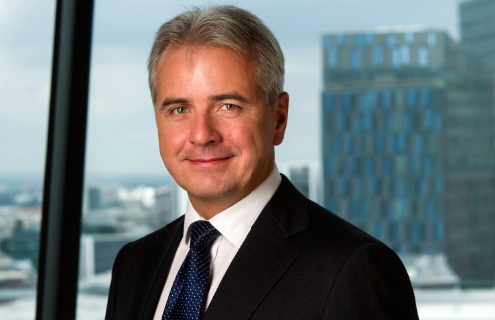Raiffeisen Bank International AG (RBI)
Attila Szalay-Berzeviczy
28 May 2014
A slim and efficient production environment exists where clients can gain maximum synergies by using Raiffeisen Bank International as a provider in a multi-market environment, says Attila Szalay-Berzeviczy
 Image: Shutterstock
Image: Shutterstock
The CEE region still looks towards an uneven economic outlook over the next 12 months. How does Raiffeisen view the growth outlook for CEE and CIS states?
The current economic climate does still deliver a rather divergent picture on the country level going forward. The reason is mainly based on two factors: the still sluggish recovery in Western Europe that does not provide full support to the eastern economies and the uncertainties around potential sanctions towards Russia. In our main scenario, we continue to expect that Russia will not extend its territorial claims into eastern Ukraine, but does not feature an escalation with military means or severe economic embargoes between the EU/US and Russia.
However, just these elevated tensions and the acrimonious mood between Moscow and Kiev are enough to make the negative effects for both economies and their financial markets even worse. By contrast, prospects for Poland, the Czech Republic and Hungary have continued to improve in the first few months of 2014, prompting us to revise the GDP growth projections upwards. We expect the overall situation to stabilise slightly and to add a bit more comfort to the capital markets and the real economies.
Talking of Russia and the Ukraine, what is your main scenario bearing the recent developments into account?
The main factor that will determine the magnitude of the negative impact of the political conflict is to what extent the west will intervene with economic sanctions against Russia. We also see risks that political uncertainty and turbulence on the financial markets will discourage foreign direct and portfolio investments. Moreover, the RUB has come under serious pressure over the past couple of months.
However, we forecast moderate sanctions only. We do not believe that fully fledged trade and financial sanctions will be implemented by the west.
Do you anticipate an increase in listing activity on CEE and CIS exchanges in the next 12 to 24 months?
Whereas we observed quite solid listing activities in Poland, Russia and Romania during the last years, other countries such as Hungary, Czech Republic and Croatia had almost no IPO activity. Since 2011, we have noticed a substantial slowdown in the IPO market in the Central and Eastern European (CEE) region due to global stock market turbulences, debt crisis uncertainties and the deterioration of the macroeconomic environment.
In the near term, we see equity markets still under pressure (eg, institutional investors are reducing their stakes in risky assets that affects CEE stocks in particular, in some countries governments cut their payments to pension funds, etc).
However, in the long run we are rather optimistic regarding a stock market recovery and therefore expect that listing activities will increase at least to some extent. But we do not have an overly positive view that listing activities in the CEE region will come back to all-time highs any time soon.
How is RBI positioning itself in response to these economic drivers that you have outlined? What are the major challenges that your organisation faces in expanding its business?
CEE provides a structurally attractive environment with economic growth rates that are clearly above the average of the eurozone. Generally, Raiffeisen Bank International’s diversification—we are a universal bank present in 15 CEE markets—proves to be very valuable. Challenging developments in single units are more than compensated by strong performance in others. Generally, we plan to foster our relationship-based business model, focusing on prime corporate and retail customers. We see further business opportunities in offering capital markets products to our CEE customers.
The major challenges we are currently facing are regulatory requirements, as implemented by the European Banking Authority and others, the banking levies that differ in the various countries we are active in, and of course the current developments in Russia and Ukraine. But we are sure that all of these challenges are manageable, as Raiffeisen Bank International is one of the leading banks in Europe’s growth region CEE.
The one-stop-shop is now available throughout the CEE region, providing our client base with attractive synergies at their end. The benefits comprise of a harmonised IT landscape, lower cost base and a powerful governance model within our organisation. Thus, the current infrastructure allows us to pass on the benefits to our clients and to meet their high expectations in terms of risk, product range, service quality, and last but not least, pricing.
This fact results in a slim and efficient production environment where the client can gain maximum synergies by using us as provider in a multi-market environment, ie, the more markets are covered via us the higher the benefits for our customers. The future focus of our organisation is to build on the current base and to exploit the environment and structure further for the sake of efficiency and client benefit.
Furthermore, from the infrastructure entities’ point of view, we will face changes towards more interoperability. However, the pace will not be very fierce as every country seems trying to hang on to their domestically dominating position as long as possible. We will experience more multimarket listings or listings abroad. The issuers obviously need to count on a liquid and attractive stock exchange. Due to the current economic climate, some issuers will be successfully lured away from their home markets to more liquid ones.
← Previous interview
Bravura Solutions
Tony Klim
Next interview →
Bank of America Merrill Lynch
Stephanie Colaric
 Image: Shutterstock
Image: Shutterstock 